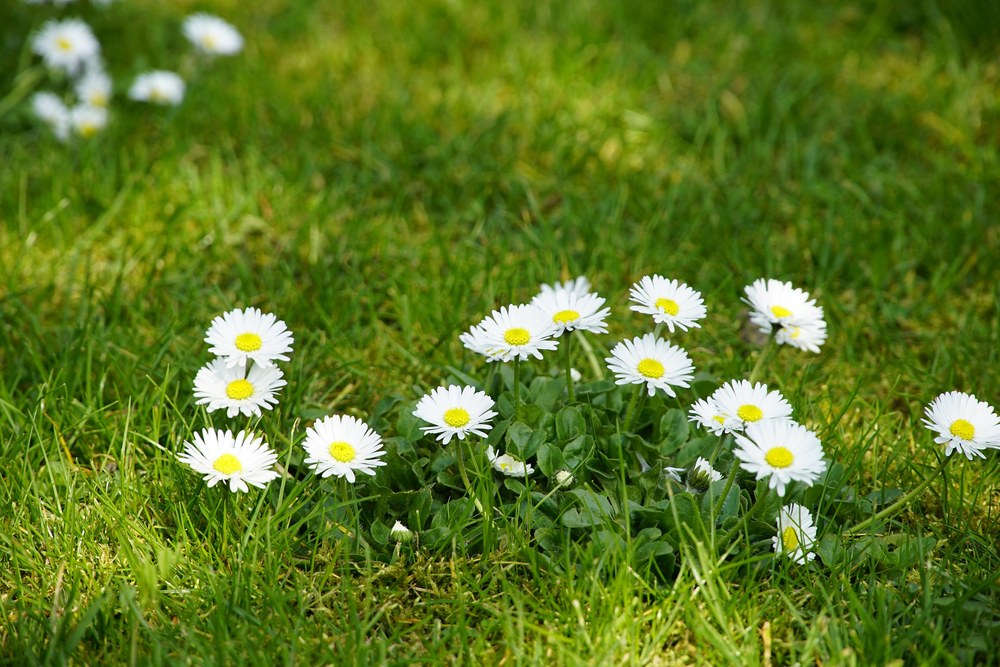Posted: April 2, 2021
One of the most common and cheery flowers that pops up in spring, the English daisy or common daisy is also the birth month flower for April. There is something refreshing about bright white petals surrounding the sunny yellow center of the English daisy, which announces that spring is finally here.

Bellis perennis in a lawn, photo from pixabay
The Old Farmers' Almanac, many floral-related websites and other sources of folklore indicate that the daisy conveys many meanings--innocence, simplicity, childlike joy and playfulness, happiness, good luck, new beginnings, loyal love, and purity. It is a flower given between friends to keep a secret; the daisy means "I'll never tell." Daisies are presented to new mothers, representing fertility and motherhood.
According to Roman mythology the daisy also symbolizes chastity, modesty, and transformation. This meaning is derived from the story of Vertumnus, the god of seasons who loved a nymph, Belides. He pursued her to the point where she transformed herself into a daisy to escape his unwanted attention. The daisy's Latin name "Bellis" or "Bellus" is derived from Belides and means pretty. The species name "perennis" means lasting through the year.
It is believed that the word "daisy" is derived from the Old English saying, "day's eye." This is because many of the flowers that we commonly call daisies close at night and open in the early morning sunlight. The term "fresh as a daisy" comes from this characteristic, which means that someone has had a good night's sleep.
The English daisy is an herbaceous perennial in the family Asteraceae, native to northern Africa, western Asia, and Europe. Daisies grow in zones 4 to 8 and are found throughout Pennsylvania. They bloom from May to July in full sun to part shade and are 3 to 6 inches in height, with a 1 to 1.5 inch bloom of white ray-like petals surrounding a yellow center and a sprawling, flattened rosette of small, spatula-shaped, dark green leaves.
A low maintenance plant with no serious insect or disease problems, the English daisy grows well in organically rich, consistently moist, well-drained soils, but is intolerant of drought. It is usually grown from seed and may be started indoors in winter for bloom the following spring or summer. However, summer heat can cause the plant to decline.
Although admired for its many positive attributes, Bellis perennis, has a mixed reputation. Depending on personal experience, it can be an attractive low-spreading ornamental flower enhancing borders, rock gardens or containers. By contrast, it may be a common, persistent weed of lawns, fields and abandoned areas. The daisy has naturalized in parts of the northern United States and its introduction to non-native environments has made it an aggressive species, which can be difficult to control or eliminate.
According to Penn State professor of turfgrass, Peter Landschoot, Ph.D., and Penn State Extension educator, Tanner Delvalle:
English daisy is a weed of home lawns, parks, and other turf areas and often found growing in moist, fertile soils and in full sun or partial shade. It produces basal rosettes that spread and form patches in turf, with small flowers that grow close to the ground. When flowering, it is an attractive weed species that occurs in the turf, and some landowners prefer to allow scattered patches to remain. Plants form short, thick rhizomes which produce new plants at nodes and produce flowers during the spring. Seeds can be wind-disseminated, which gives rise to new plants.
You can find more information in their article, "Lawn and Turfgrass Weeds: English Daisy"
So, is the daisy a pretty wildflower or an annoying weed, a cultivated flower, or a nuisance plant? The daisy's sentiments of innocence, purity, and love all capture the essence of spring's breezy and carefree atmosphere. But the daisy's characteristics of fertility, new beginnings and transformation can be just as easily associated as a vigorous weed infiltrating and changing a flourishing and well-planned landscape.
~by Joan Banyas, Luzerne County Master Gardener Trainee

